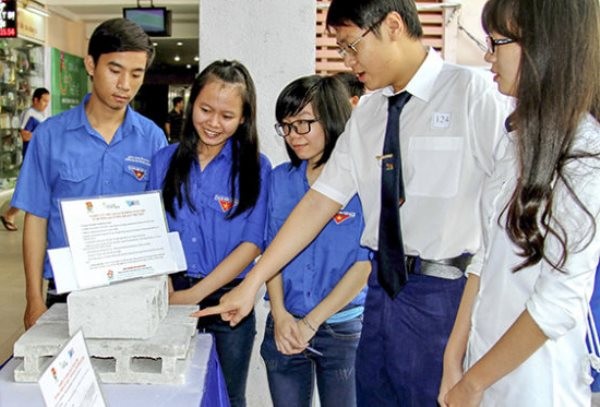Fabrication of unburnt bricks from paper
After 7 months of research, Nguyen Cao Hoang Sang (construction industry of Ho Chi Minh City University of Architecture) successfully fabricated unburnt bricks made from waste paper.
>> Glass is self-cleaning and doesn't scratch
>> Construction materials regulate heat
New construction materials environmentally friendly
Scientific research works are highly appreciated by experts on their applicability in practice. The project also won the first prize of Euréka 2014 Scientific Research Student Award, organized by Ho Chi Minh City Youth Union and National University.

Nguyen Cao Hoang Sang (second from right) introduced a prototype model of unburnt bricks made from waste paper for young people.
Environmentally friendly materials
Hoang Sang has long wondered, looking for many research solutions, producing environmentally friendly materials. Refer to the document, many groups of students before each study, successfully fabricated porous concrete, coconut concrete but the effect is not high when the price is high and there are many limitations.
Since then, Sang thought of making unburnt bricks with scrap paper materials to catch the trend in the construction industry.
At first Sang went to collect scraps of paper from all sources, from classrooms, photocopy shops, bookstores . to grind them into small pieces and mix them with sand and cement to form a brick concrete mixture. The two main components that make up this unburnt brick are adhesives and aggregates.
In it, adhesives include cement and water. The aggregate is pulp and sand. Depending on the purpose of use, change the grading rate to create unbaked bricks as desired.
Sang said, he has created two types of bricks : bricks with 35 kg of force to build walls in the house, replacing the traditional clay bricks with four holes and bricks with 75 kg of force used to build cover outside, replacing two-hole card tiles, made from baked clay, are popularly used in the current high-rise construction industry.
To manufacture unburnt bricks, Sang has to research and manufacture paper mills with parts: containers, engine frames, blades, drills, engines .
The study created the two types of bricks mentioned above, to cast seven different types of bricks to determine preliminary grading, surface after drying and weight of bricks.
After that, Sang continued casting bricks to determine the strength of each brick. Finally, Sang took two types of bricks soaked in water for a week. When removed the edge does not peel and ensure the necessary hardness. In the heat test section, bricks are burned on oil stoves, for 30 minutes without being caught, not burning underground.
Sang said: ' The period of testing the bearing strength of bricks is very important to determine if the bricks meet the standard of use. The bearing strength of bricks is expressed by the limit of compressive strength, bending strength, tensile strength, shear strength. It is necessary to meet these standards to be called ' okay '.
Competitiveness
Unburnt bricks made from waste paper have a simple production process that can be applied to small brick factories, low initial investment . This type of tiles is environmentally friendly, ensures good bearing capacity, sound insulation, and insulation.
If Sang's topic is applied in practice, the price of each unburnt brick from waste paper is about VND 6,000.
' The outstanding advantage of brick made from waste paper is light. So construction workers will be easy, investors reduce costs as a foundation. The ability of sound insulation, insulation of tiles made by Sang is also higher than aggregate cement bricks, the competitiveness will be high when marketed '- Sang said.
When put into mass production, waste paper bricks also make use of waste humus in paper mills, reducing the risk of environmental pollution very high.
In the coming time, this construction engineer will study to build a kind of construction additive in order to bond unburnt bricks from waste paper to improve the practical application.
- Production of unburnt bricks polymerized from waste
- Unburnt bricks produced from agricultural residues
- Build a brick house made of paper
- Unburnt building materials protect natural resources and environment
- Technology for pumping crab bricks, painting for guava
- Video: Turning ocean waste into building bricks
- Optimal materials from nature
- Thousands of years old bricks were discovered
- Recycled paper can be reused more than 80 times
- Discovered many ancient thousand-year bricks in Ho's Citadel
- Invent for ink removal on paper for 5 minutes
- New paper antibacterial, waterproof
 Daily use inventions come from universities
Daily use inventions come from universities Special weight loss device helps prevent appetite
Special weight loss device helps prevent appetite 8 inventors were killed by their own inventions
8 inventors were killed by their own inventions Iran invented a motor car powered by water
Iran invented a motor car powered by water